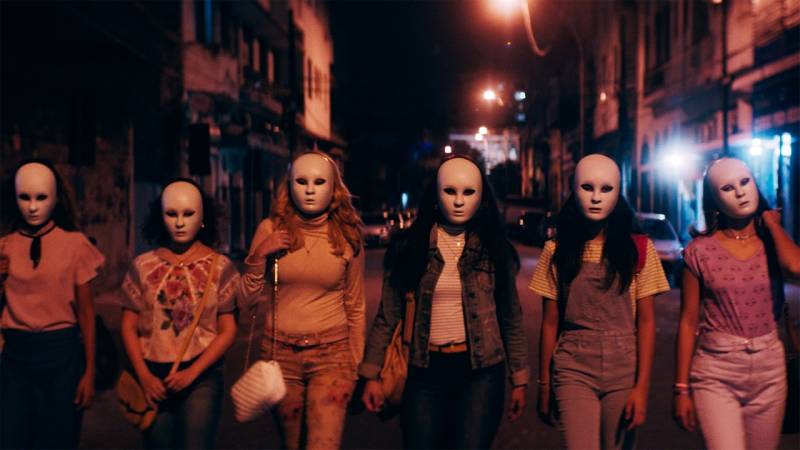We open up on a gang of masked vigilantes. They corner a young girl, agreeing to free her if she “submits” herself to Jesus and religion. One of the gang members is Mariana (Mari Oliveira), who wears a very different mask to the one she dons at night. It’s a face filled with blossoming smiles and cherubic eyes, presenting herself as the model one young woman. The film then follows Mariana as she reconciles the darker side of her life with the purer, more angelic face that she hopes to wear during the daylight.
Shot in minimalist hues of greens and blacks, the landscape is filled with director Anita Rocha da Silveira’s taste for desolate centrepieces. Broadly speaking, the film follows the trappings of horror filmmaking, but it goes beyond that, presenting a society that reveres and hides from religious figures. In fact, despite appearing in a number of religious garments, Mariana seems tormented by the religion: figures of Jesus Christ follow her with a cold, quietly sinister confidence, egging her to capture and torment young, vulnerable women to join their religious sect (or would it be better to call them a cult?) Likewise, the gang wear masks that recall the steel mantles worn by the robbers at the beginning of Heat, cloaking their identities from the assailants in the hope of exercising the seriousness of their mission. Egos, however, get thrown into the mix, and the assailants find themselves at an impasse. Are they warriors of mighty religion, or vigilantes looking to satisfy their own ambition?

Here, in only her second feature, da Silveira delivers something that is urgent, feminist and immensely satisfying. An avid horror buff, da Silveira lets her inner fangirl guide her, and although the film tips its hat at the trappings of cinema – a conversation held at the bus stop could easily have come from a George Romero film, albeit one shot in Portuguese. Medusa is confident enough in the political backdrop to present something that feels comforting but new. From the opening frame, da Silveira grounds audiences in the mind of a woman, playing out a thoughtful dance sequence where a lady allows her body to become part of the surroundings, just before her surroundings (ie, society), unwittingly become a part of her. Da Silveira’s attack on the senses is visual, supported by frenzy, nausea and disappointment women experience almost everyday of their lives.
And it is this apotheosis where da Silveira and Mari Oliveira demonstrate their bravest and most truthful work. In a genre that nominally casts women away or bait for the film’s ineffably charming predator, we find that it is women who drive this film, tipping the genre on its head. And although it does not entirely excuses its runtime (it says everything it needs to in 90 minutes, but plods on for another 30), Medusa‘s greatest success is that it demonstrates what it is women face when they are squared up against a religious enterprise, and a society that aches to box them into the roles the Bible has given them.
Medusa is in cinemas on Friday, July 14th.










